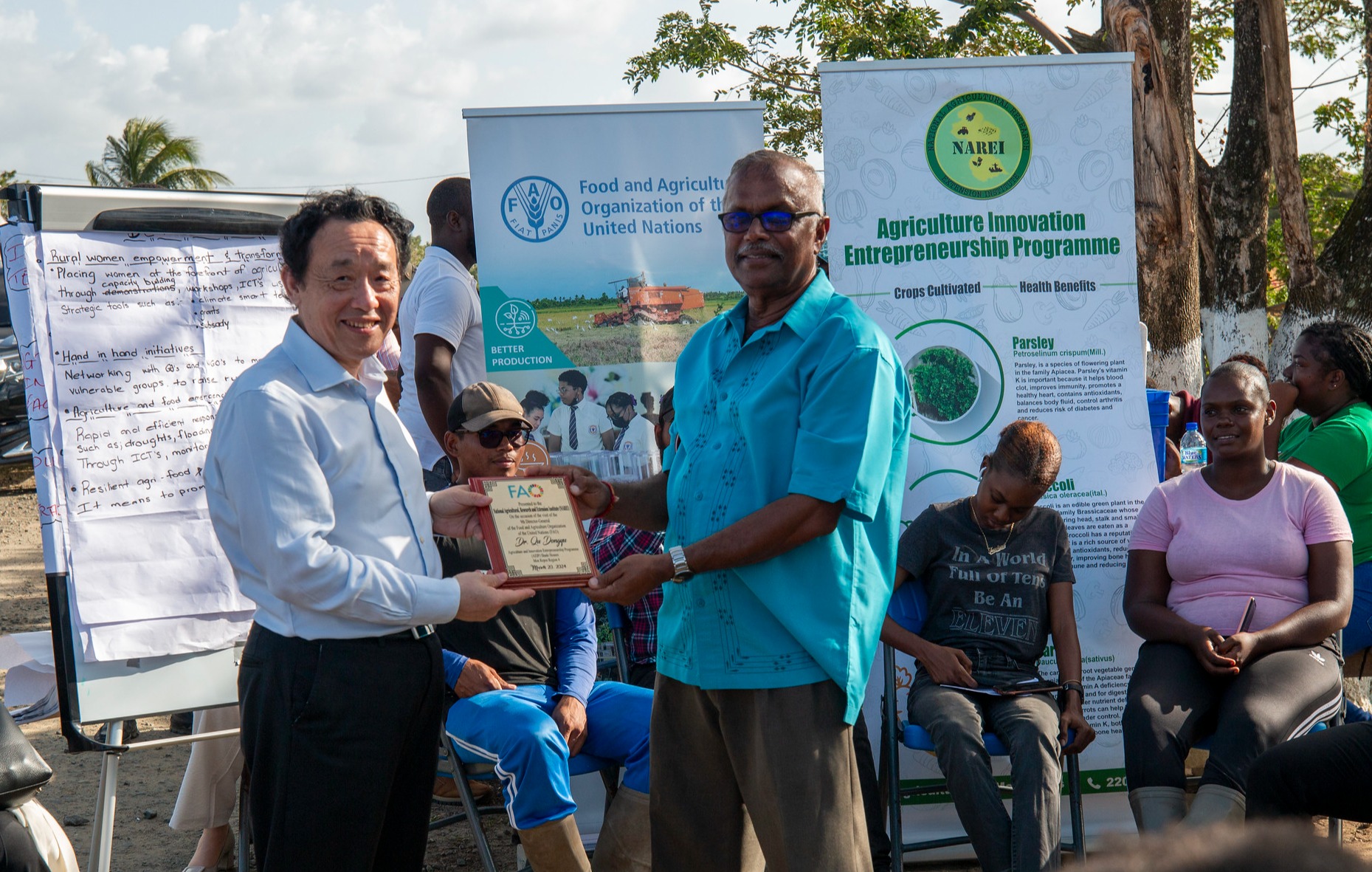QU Dongyu visits agrifood solutions initiatives in Guyana

©FAO/Max Valencia
Georgetown, Guyana - In the context of the 38th FAO Regional Conference for Latin America and the Caribbean in Guyana, the Director-General QU Dongyu made a series of field visits to witness FAO and country-led initiatives that are helping transform the nation’s agrifood systems.
Drone Technology to monitor rice production
At the Burma Rice Research Station in Mahaicony, Qu received a briefing on the progress of a pilot initiative utilizing drone technology to assist small producers in identifying pests, diseases, and nutritional issues that may pose threats to their rice crops.
By harnessing geographic information system (GIS) technologies, drones can effectively monitor rice cultivation areas and equip farmers with valuable information to make data-driven decisions regarding crop management.
“Changing the mindset is essential for scientists and farmers in the country to pursue higher yields and market returns. Guyanese paddy rice will have great market potential with value-added byproducts, such as fish and crawfish, mainstreamed in its rice production,” the FAO Director-General said during the visit.
This pilot project is a result of collaborative efforts between FAO and the Guyana Rice Development Board (GRDB) aimed at promoting digital transformation in the rural sectors of the country. Launched last year, the initiative has received technical and financial support from the FAO-China South-South Cooperation project and a Regional e-Agriculture project, which are both facilitating rural digital transformation processes across 12 countries in the region.
The endeavor to bring connectivity and digital tools to the rural sectors of Latin America and the Caribbean aligns with broader efforts to achieve inclusive rural transformation. The aim is to cultivate more efficient, inclusive, resilient, and sustainable agrifood systems for better production, better nutrition, a better environment, and a better life, leaving no one behind.

Innovation to manage fisheries data
During a visit to the Guyana Fisheries Department, the Director-General observed an online demonstration of the FAO Calipseo web-based platform, a new fisheries data system designed to streamline the management of fisheries data and facilitate the production, analysis, and reporting of fishery statistics.
The Director-General commended Guyana for taking the lead in establishing this monitoring system in the region. He emphasized the importance of data-driven decision-making for the development of the fisheries and aquaculture sector in the country. He also encouraged the nation to expand the application of the system to include tracking fish migratory patterns, fish consumption trends, and aquaculture activities. Additionally, he highlighted aquaculture as a sustainable source of protein for Small Developing States like Guyana.
The Calipseo tool represents an innovative modular approach to managing data and information flow at the national level and has already been deployed in neighboring countries such as Suriname and Trinidad and Tobago.
The Calipseo modules encompass the management of users, standard reference data (species, gear types, vessel types, fishing zones, etc.), including mapping with international classifications, and administrative data management, such as vessel, fishers, and companies’ registries, with the issuance of licenses and the collection of fisheries-dependent data.

Hydroponics to empower local communities
The the FAO Director-General also visited the National Agriculture Research and Extension Institute (NAREI) and the Victoria Greens hydroponics facility at Mon Repos, where he received a briefing on a hydroponics project led by Guyana.
The Government has identified hydroponics as a crucial technology that can empower local communities by promoting sustainable farming practices, enhancing economic development, and fortifying the agricultural sector's resilience and productivity.
This technology enables year-round crop production, offering a solution to seasonal limitations that hinder traditional vegetable crop cultivation. Recently, the Ministry of Agriculture engaged FAO to adopt the Hand in Hand approach for further developing hydroponics in the agricultural sector, aiming to transform the country’s agrifood system.
During the visit, Qu also interacted with young entrepreneurs and their mentors participating in the Agriculture and Innovation Entrepreneurship Programme launched by the President of Guyana Mohamed Irfaan Ali in 2022. This initiative targets youths to become agribusiness owners. Over 100 recent graduates from the University of Guyana and the Guyana School of Agriculture are involved in shade house farming, cultivating crops such as broccoli, cauliflower, carrots, romaine lettuce, and iceberg lettuce.
